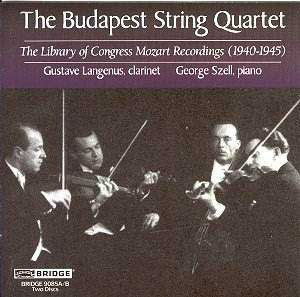Volume Ten in the series of live Library of Congress
recitals is a very generous set devoted to the Budapest Quartet’s Mozart.
It also cannily covers much ground in presenting the full quartet in
a 1943 K421 and K464 and then joined by Langenus in the Clarinet Quintet,
Szell in the Piano Quartet and to finish Roisman, Kroyt and Schneider
slim down for the E Flat Major Divertimento. The discs are especially
valuable for the collective light shone on the Quartet’s Mozart performances,
which tend to be overshadowed rather by their Beethoven and Haydn, and
also in the light of the almost contemporaneous recordings made of the
same works. A greater sense of elasticity is almost always present in
the concert performances, with congenial surroundings, sympathetic colleagues
and a greater sense of expressive breadth adding to the real rewards
of this splendid slimline double.
The Clarinet Quintet brings to the fore the Belgian
clarinettist Gustave Langenus, born in Malines in 1893, whose early
success in England led to a place in Henry Wood’s Queen’s Hall Orchestra.
He was subsequently hired by Walter Damrosch for the New York Symphony,
left for the Philharmonic and then began a long career as chamber player,
soloist and teacher. A consummate romantic with a beautiful rounded
tone he blends with the string players in a performance of marvellous
intimacy and projection. They maintain a good tempo in the Allegro,
but flow especially convincingly in the Larghetto where Langenus’s occasionally
almost flute like upper register lends the movement a distinction all
its own. In the Menuetto there is some vital and elegant phrasing and
the finale is precise but with sufficient space to breathe – and I admired
cellist Mischa Schneider’s bass accents here. Comparison with the famous
recording the Budapest Quartet made with Benny Goodman is almost all
in favour of this Langenus concert. Goodman always regretted that he
and the Budapest had not played the work in concert before recording
it – the result is an attractively played but rather metrical performance,
with heavy bar lines audible, and a sense of over caution wearyingly
pervasive. (It’s less well known that the previous year he had been
booked to record it with the Pro Arte Quartet but had apparently turned
up at the recording studios after an overnight trip with a soft reed
instead of the harder ones used by classical clarinettists, blew a few
disappointing notes, packed up and left). Langenus by contrast was a
practised exponent of the chamber literature – far more experienced
in fact than his younger colleagues – and the resultant performance
is one worthy of the music.
For the E Flat Major Piano Quartet the Quartet are
joined by a sometime collaborator, George Szell, whose splendid playing
in the Brahms F Minor Quintet at the Library of Congress I recently
reviewed and greatly admired (Bridge 9062). Together with Szell they
also recorded the two Quartets – as they did later with Mieczyslaw Horszowski.
In 1945 at the Coolidge Auditorium they played the E Flat Major over
two nights and the performance presented by Bridge is a composite; the
first movement comes from the first performance, the second and third
from the following day. Harris Goldsmith, as ever an erudite guide,
notes the differences in flexibility between this concert and the commercial
disc and it’s quite true; analogous, in fact, to the Langenus-Goodman
disparity in the greater breadth and flowing flexibility attributable
to the live performance. There is also greater metrical freedom and
less abrupt and sharpened attacks.
In the Divertimento Roisman, Kroyt and Schneider conjoin
in a reading of considerable élan. Goldsmith points out that
their 1940s aesthetic shares a profile – and a speed – with that of
the Heifetz-Primrose-Feuermann recording. This is true to an extent
though the Budapest players are actually slower in almost all six movements;
the expressive freedom thus gained are ones of flexibility and familiarity-
they’d played this music longer and deeper than the more celebrated
trio. The Budapest reading fits somewhere between that extreme of hyper
virtuosity and the more pliant romanticism of the only other then commercially
available disc, by the Pasquier Trio, altogether a more reflective affair
and attractively so. In the Quartets the players are commandingly fluent.
Some scuffs mar the opening movement of K421 – the sound quality varies
in places but is never less than acceptable and often a good deal more
so - and some may feel they open rather too casually but the Andante
is fine. Again maybe the Menuetto falls slight prey to a sense of manipulation
but the final movement is elegantly decisive. Not a stellar performance
but a good one. K464 is better though I have reservations about the
Menuetto again which is rather too manicured for me. The integration
and tonal play of the two violins in the opening Allegro is splendid
however and the Andante, lasting over eleven minutes, flows seamlessly
– a pity about the chuffs and clicks from 2.00 onwards but you can listen
through it to the pleasure beyond.
No complaints about presentation and booklet; few about
the recording or playing either. This is a splendidly engrossing set,
full of life and engagement, and strongly recommended.
Jonathan Woolf


